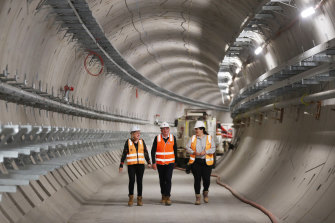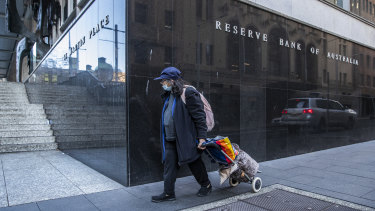For our free coronavirus pandemic coverage, learn more here.
Victoria’s unemployment rate has fallen to its lowest level in almost 50 years, shrugging off January’s Omicron wave as women rushed back into the jobs market, setting up the economy for the rest of the year.
But the rebound in employment could come with a financial sting if the Reserve Bank is forced into tamping inflation risks by bringing forward expected interest rate rises.
Major infrastructure projects, like Victoria’s Metro Tunnel project, are supporting the state’s low unemployment rate.
Data from the Australian Bureau of Statistics released on Thursday showed the national unemployment rate steady at 4.2 per cent in January despite hundreds of thousands of people being forced to take sick leave or isolate themselves because of the outbreak of the Omicron COVID-19 variant.
In Victoria, the jobless rate fell by 0.2 percentage points to less than 4.1 per cent. The last time unemployment in the state was that low was in 1974.
The number of Victorians deemed unemployed fell to 146,700, the lowest in almost a decade, while a record number of women across the state now have full-time work.
The low level of unemployment in Victoria is partly due to a sharp fall in the size of the state’s labour force. There were 62,000 fewer people over the age of 15 across Victoria in January compared to March 2020, due to a drop-off in immigration and international student arrivals.
But the participation rate – the proportion of people in work or looking for it – remains at near-record levels.
Among Victorian women, it reached an all-time high level of 62.4 per cent, almost a full percentage point above its pre-pandemic level.
Since Victoria largely reopened in the wake of the Delta outbreak in October, the state’s male jobless rate has fallen from 5 per cent to 3.9 per cent while among women it has tumbled from 6.3 per cent to 4.3 per cent.
Treasurer Tim Pallas said the government had backed the state’s businesses and community with significant support that was now paying dividends.
“The underlying strength of the Victorian economy shines through in these figures and that’s great news for workers and businesses across the state,” he said.
Nationally, Omicron had its biggest impact on hours worked, which fell by 8.8 per cent or 159 million hours, as people fell sick or were forced to isolate at home.
The ABS noted between 90,000 and 100,000 people are usually away from work sick for an entire week during January. This year, it was about 450,000. Hours worked fell by 13.5 per cent in NSW and 13.2 per cent in Victoria but in Western Australia, which effectively barred travel from other parts of the country, there was a 1.7 per cent increase.
The number of Australians unemployed also increased, lifting by 5600 to 580,000. The total number of people unemployed is 143,200 lower than in March 2020, ahead of the pandemic recession.
While Victoria’s jobless rate fell, it lifted by 0.2 percentage points in NSW to 4.2 per cent. The biggest fall in the jobless rate occurred in the ACT, down 1.3 percentage points to 3.2 per cent. It also fell in Queensland (to 4.4 per cent), Tasmania (3.8 per cent) and the Northern Territory (3.8 per cent). It increased in Western Australia (to 3.7 per cent) and South Australia (4.8 per cent).
The RBA is now facing pressure to lift official interest rates as early as June.Credit: Louie Douvis
The Reserve Bank, which has official interest rates at 0.1 per cent, has said it is plausible interest rates could climb this year to deal with inflation pressures caused by a tight jobs market. But financial markets believe the bank will start lifting rates in June, taking them to 1.25 per cent by year’s end.
Ahead of the Global Financial Crisis in 2008, when unemployment was at 4.2 per cent, the RBA had the cash rate at 7.25 per cent. Inflation then was at 4.4 per cent compared to today’s 3.5 per cent.
The unemployment rate is now expected to fall to the low-3s by the end of the year on ANZ senior economist Catherine Birch’s forecasts. This would push wages growth up and keep inflation above the RBA’s target, resulting in significant interest rate rises.
“This is consistent with our expectation that the RBA will start hiking the cash rate in the third quarter of 2022, reaching 0.75 per cent by the end of 2022 and 2 per cent by the end of 2023, with more gradual rises to follow,” she said.
The Reserve Bank’s latest outlook forecast the jobless rate to hit 4 per cent in June, before falling to 3.75 per cent until 2024. The tight labour market is expected to contribute to wage growth, with the RBA waiting for inflation and wage rises to post several solid increases before lifting interest rates.
KPMG chief economist Brendan Rynne said four out of nine jurisdictions now have an unemployment rate in the 3 per cent range.
“This data … will provide the RBA with the evidence it needs to move more rapidly in tightening interest rates,” he said.
Bank of Queensland chief economist Peter Munckton said the jobs market was in a strong position with all regions benefiting.
Provided there is not another wave of the coronavirus over the next eight to 10 weeks, he said economic growth would be very strong in the June quarter.
“The key question though is how many jobs can be created without leading to other economic problems (particularly inflation),” he said. “That is currently what we are finding out. The answer to that question is also the answer to when interest rates will begin to rise”.
Australian Chamber of Commerce and Industry chief executive Andrew McKellar said the jobs figures were further evidence governments had to invest more heavily in upskilling the workforce.
“The ultra-low unemployment figures make clear that further emphasis is needed to boost workforce participation, invest in skills, and VET, and establish an ambitious skilled migration program to plug widespread workforce shortages,” he said.
There was some positive news on migration. Overseas arrival and departure figures from the bureau showed a lift in the number of international students, tourists and migrants.
More than 4300 international students came to Victoria in December last year, compared to just 30 for the same month in 2020.
Most Viewed in National
From our partners
Source: Read Full Article


